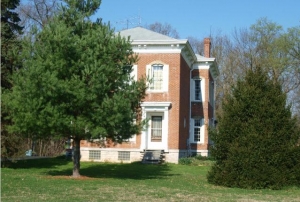Book
Displaying items by tag: Ankeney
This house was originally located on Ankeney Road on the property owned by Mary and Phil Ankeney. It was donated to the Beavercreek Historical Society by them and rebuilt at Wartinger Park in 1993. Samuel Ankeney, age 19, bought the Ankeney House in 1830 along with 210 acres after his father died in 1830, having just arrived from western Maryland. Samuel built a kitchen for his mother and added it onto the house. He was the oldest of ten children.
The cabin was about four years old when Samuel Ankeney bought it from John Davis. The Ankeney House fireplace was rebuilt in 1997 with bricks from the old Beavercreek High School which had burned in 1996.
 Ankeney House Kitchen 1
Ankeney House Kitchen 1
Ankeney House Kitchen 1
Ankeney House Kitchen 1
 Ankeney House Kitchen 2
Ankeney House Kitchen 2
Ankeney House Kitchen 2
Ankeney House Kitchen 2
 Ankeney House Living Room 1
Ankeney House Living Room 1
Ankeney House Living Room 1
Ankeney House Living Room 1
 Ankeney House Living Room 2
Ankeney House Living Room 2
Ankeney House Living Room 2
Ankeney House Living Room 2
 Ankeney House Kitchen 3
Ankeney House Kitchen 3
Ankeney House Kitchen 3
Ankeney House Kitchen 3
 Ankeney House Kitchen 4
Ankeney House Kitchen 4
Ankeney House Kitchen 4
Ankeney House Kitchen 4
 Ankeney House Plumbing
Ankeney House Plumbing
Ankeney House Plumbing
Ankeney House Plumbing
 The Early Oven/Stove
The Early Oven/Stove
The Early Oven/Stove
The Early Oven/Stove
https://www.beavercreekliving.com/book/itemlist/tag/Ankeney#sigProId69858c2753
Proceed to the stop sign at Dayton-Xenia Road.
Ahead of you are a couple of homes in a wooded grove at 1835 Dayton-Xenia Road, the Ankeney-Westbeld House built in the Vernacular style by Samuel Ankeney in 1853 on 12 acres of the 212 acre David Ankeney Farm. An earlier log cabin was razed to make way for the large three-layer thick brick home. The limestone for the foundation is believed to have come from Mr. Herring’s quarry on Beaver Valley Road.
The single most expensive item in construction was a cherry newel post at a cost of $40. Son Horace Ankeney, a State Legislator and Congressman, and grandson Herman Ankeney, a State House Representative, also resided in the home.
Thanks to the Westbeld family for allowing the photographs!
 The Famous Cherry Newel Post
The Famous Cherry Newel Post
The Famous Cherry Newel Post
The Famous Cherry Newel Post
 Horace Ankeney
Horace Ankeney
Horace Ankeney
Horace Ankeney
 Ankeney-Westbeld House
Ankeney-Westbeld House
Ankeney-Westbeld House
Ankeney-Westbeld House
 Ankeney-Westbeld House 2
Ankeney-Westbeld House 2
Ankeney-Westbeld House 2
Ankeney-Westbeld House 2
 Ankeney-Westbeld House Barn
Ankeney-Westbeld House Barn
Ankeney-Westbeld House Barn
Ankeney-Westbeld House Barn
 Ankeney-Westbeld House Barn 2
Ankeney-Westbeld House Barn 2
Ankeney-Westbeld House Barn 2
Ankeney-Westbeld House Barn 2
 Samuel Ankeney
Samuel Ankeney
Samuel Ankeney
Samuel Ankeney
https://www.beavercreekliving.com/book/itemlist/tag/Ankeney#sigProId0a645282f1
At 1035 Ankeney Road you’ll find the Albert Ankeney House. Built in 1872 by Albert Ankeney Sr., grandson of pioneer David Ankeney, it is of the Italianate style designed by renowned Dayton architect M. Borrow. The limestone came from the Archer quarry and all 66,000 bricks were fired onsite.
This is the grandest and best preserved of all the Beavercreek historic homes and retains its original charm and glory.
https://www.beavercreekliving.com/book/itemlist/tag/Ankeney#sigProId792b509b91
Just ahead is the Filer Cabin at 1228 Ankeney Road. At first glance, it appears a traditional frame farmhouse of the early 20th century. In fact, it is a well preserved log cabin circa 1820 that was covered with wooden lap siding, possible built by the Heddleson family.
Of historical significance, the first recipe for making artificial color for butter in the world was perfected in a shed that stood next to the cabin. This occurred shortly after August 2, 1866 when the USDA announced that the coloring of butter was now permitted by law.
Also alleged, but unsubstantiated, is that there was a blacksmith shop on the property that led to the making of the first leather mailbags.
Navigation
Latest Blog Posts
- Just Don't Call Us Late For Dinner...
- Remember When...
- What A Long, Strange Trip It's Been...
- Snow Down = Slow Down
- School Bus Safety - Just Do It!
- Stevenson Road Covered Bridge
- Our Road Crews Are Worth Their Salt!
- The Most Colorful Of Seasons!
- Popcorn Fest! - Then And Now
- Pre-School Paradise!
- Remembering Riffles
- Ten Year Anniversary Of The Beaver Statues








